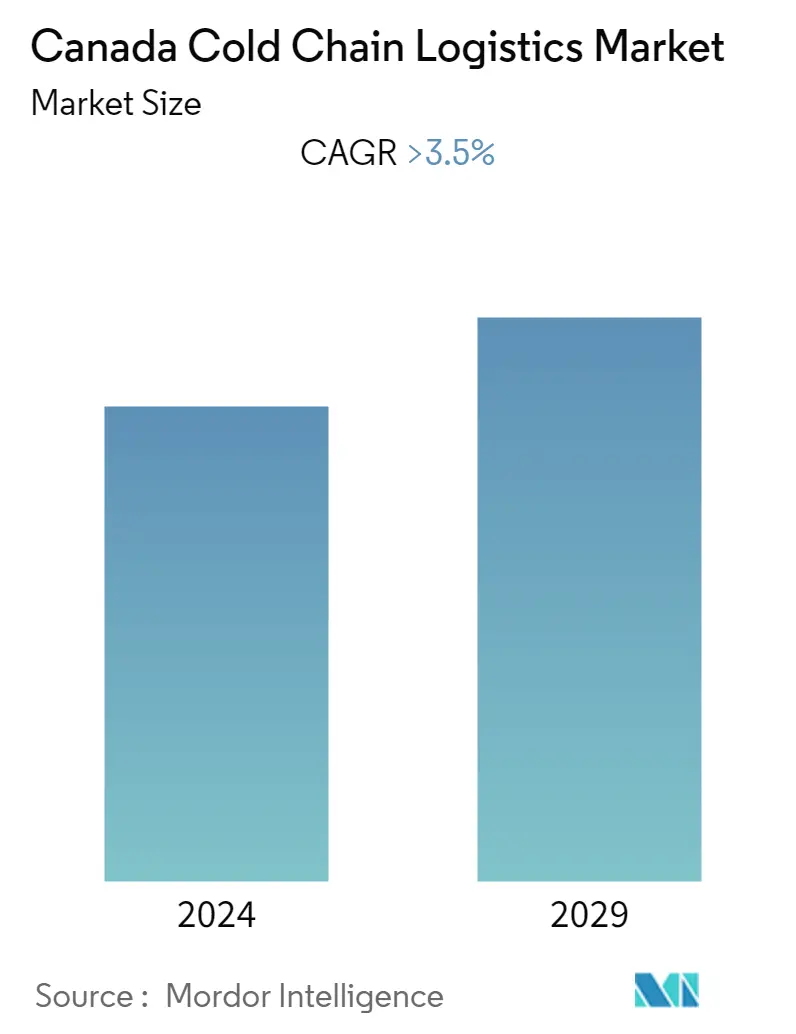Market Size of Canada Cold Chain Logistics Industry

| Study Period | 2024 - 2029 |
| Base Year For Estimation | 2023 |
| Forecast Data Period | 2024 - 2029 |
| CAGR | > 3.50 % |
| Market Concentration | High |
Major Players
*Disclaimer: Major Players sorted in no particular order |
Canada Cold Chain Logistics Market Analysis
The Canada Cold Chain Logistics market is valued at about USD 6.20 billion in the current year and is expected to grow at a CAGR of more than 3.5% during the forecast period.
- Crossborder supply chains are critical to the Canadian food sector, with significant volumes of food and agricultural products moving across the Canadian-U.S. border daily. The United States accounts for over 50% of the value of all Canadian agriculture and agrifood exports and around 60% of the value of Canadian food imports. The United States is a net importer of Canadian beef and cattle, Canada relies heavily on seasonal imports of fresh produce from the United States and Mexico. Cold chain logistics were important for a majority of the imports and exports as the products were perishable goods. The United States imports fresh produce worth over USD 22 billion yearly from over 125 different nations, while Mexico and Canada account for 77% and 11%, respectively, of the total fresh fruit and vegetable imports. It is critical to transport fresh produce effectively because their shelf lives are finite.
- The FSCC (food supply cold chain) is not dispersed fairly throughout the world. Ie. Canada has a strong FSCC that can maintain the proper temperature for all perishable food wherever it is needed. Despite this, it is known that the FSCC sometimes have interruptions or breaks. In Canada, 5% of avoidable food losses happen during distribution, 12% happen at the retail level, and 21% happen at the consumer level. It is thought that one of the main causes of these losses is inadequate temperature maintenance throughout the FSCC. The distance that food travels across Canada poses a significant problem for maintaining temperature. With a sizable population centred in urban regions dispersed across the nation and more communities dispersed throughout sizable rural and remote areas, Canada has a vast landmass. Road transportation is the main method used to deliver food to urban areas, whereas air transportation is used to transport food to remote places, particularly Northern villages.
- A significant global advantage for Canada lies in its numerous water ports. Ocean ports on the Pacific and Atlantic coasts open the Asian and European markets, respectively. In addition, the St. Lawrence Seaway provides expanded port service to several Canadian and U.S. locations in the Great Lakes. The Great Lakes offer outstanding intermodal logistics services to the central provinces of Canada and to the United States. Canada has distinct logistical capabilities that can be leveraged. For importing and exporting, Canada is a leader in port availability, infrastructure, and accessibility. Location, natural assets, and logistics support have created an environment to provide product distribution to global locations.
- Canada is a major exporter of fresh, chilled, and frozen meat, especially bovine products, and pork, as well as seafood products. Canada imports most of its fruits and vegetables because local production is relatively limited given the country's cold climate. The state (chilled or frozen) of imports and exports is specific to the food product. Most bovine products and salmon products that are imported and exported are fresh or chilled, while most pork imports, crab exports and lobster exports are frozen.
Canada Cold Chain Logistics Industry Segmentation
The technology and mechanism that allows for the secure delivery of temperature-sensitive goods and items along the supply chain are known as cold chain logistics. Any product that is perishable or is branded as such would almost certainly need cold chain management. Foods including meat and fish, produce, medical supplies, and pharmaceuticals could all fall under this category.
The Canadian Cold Chain Logistics Market is segmented by Service (Storage, Transportation, and Value-added Services), by Temperature Type (Chilled, Frozen, and Ambient), and by End User (Horticulture, Dairy Products, Meats, Fish, Poultry, Processed Food Products, Pharma, Life Sciences, and Chemicals, and Other Applications). A comprehensive background analysis of the Canadian Cold Chain Logistics Market covering the current market trends, restraints, technological updates, and detailed information on various segments and the competitive landscape of the industry. The report offers the market size and forecasts in values (USD billion) for all the above segments.
| By Service | |
| Storage | |
| Transportation | |
| Value-added Services (Blast Freezing, Labeling, Inventory Management, etc.) |
| By Temperature | |
| Chilled | |
| Frozen | |
| Ambient |
| By End User | |
| Horticulture (Fresh Fruits & Vegetables) | |
| Dairy Products (Milk, Ice-cream, Butter, etc.) | |
| Meats, Fish, Poultry | |
| Processed Food Products | |
| Pharma, Life Sciences, and Chemicals | |
| Other End Users |
Canada Cold Chain Logistics Market Size Summary
The Canada Cold Chain Logistics market is a vital component of the country's economy, particularly in supporting the food sector's cross-border supply chains with the United States. This market is characterized by its ability to maintain the necessary temperatures for perishable goods, which is crucial given the significant volume of food and agricultural products traded between Canada and its southern neighbor. Despite its robust infrastructure, the cold chain logistics system in Canada faces challenges such as temperature maintenance during distribution, which contributes to avoidable food losses. The vast geographical expanse of Canada, with its urban centers and remote communities, necessitates a combination of road and air transportation to ensure effective delivery of perishable goods. Canada's strategic location, with access to numerous water ports and intermodal logistics services, enhances its capability to serve as a gateway for global trade, particularly with Asian and European markets.
The market landscape in Canada is fragmented, with both global and local players like Americold Logistics, Congebec, and Lineage Logistics Ltd. These companies are leveraging technological advancements to improve their cold chain logistics operations. The market has shown resilience and growth post-pandemic, driven by the increasing demand for efficient and secure transportation solutions. Canada's role as a major exporter of fresh, chilled, and frozen products, alongside its import needs for fruits and vegetables, underscores the importance of a well-developed cold chain network. The market's growth is further supported by strategic acquisitions and expansions by key players, aiming to enhance capacity and capabilities in response to global demand for food, feed, and renewable fuels.
Canada Cold Chain Logistics Market Size - Table of Contents
-
1. MARKET INSIGHTS
-
1.1 Current Market Scenario
-
1.2 Market Dynamics
-
1.2.1 Drivers
-
1.2.2 Restraints
-
1.2.3 Opportunities
-
-
1.3 Technological Trends and Automation
-
1.4 Government Regulations and Initiatives
-
1.5 Industry Value Chain/Supply Chain Analysis
-
1.6 Spotlight on Ambient/Temperature-controlled Storage
-
1.7 Industry Attractiveness - Porter's Five Forces Analysis
-
1.8 Impact of Emission Standards and Regulations on Cold Chain Industry
-
1.9 Impact of Covid-19 on the Market
-
-
2. MARKET SEGMENTATION
-
2.1 By Service
-
2.1.1 Storage
-
2.1.2 Transportation
-
2.1.3 Value-added Services (Blast Freezing, Labeling, Inventory Management, etc.)
-
-
2.2 By Temperature
-
2.2.1 Chilled
-
2.2.2 Frozen
-
2.2.3 Ambient
-
-
2.3 By End User
-
2.3.1 Horticulture (Fresh Fruits & Vegetables)
-
2.3.2 Dairy Products (Milk, Ice-cream, Butter, etc.)
-
2.3.3 Meats, Fish, Poultry
-
2.3.4 Processed Food Products
-
2.3.5 Pharma, Life Sciences, and Chemicals
-
2.3.6 Other End Users
-
-
Canada Cold Chain Logistics Market Size FAQs
What is the current Canada Cold Chain Logistics Market size?
The Canada Cold Chain Logistics Market is projected to register a CAGR of greater than 3.5% during the forecast period (2024-2029)
Who are the key players in Canada Cold Chain Logistics Market?
Americold Logistics, Lineage Logistics Ltd, Congebec Logistics, Inc., Confederation Freezers and Conestoga Cold Storage are the major companies operating in the Canada Cold Chain Logistics Market.

